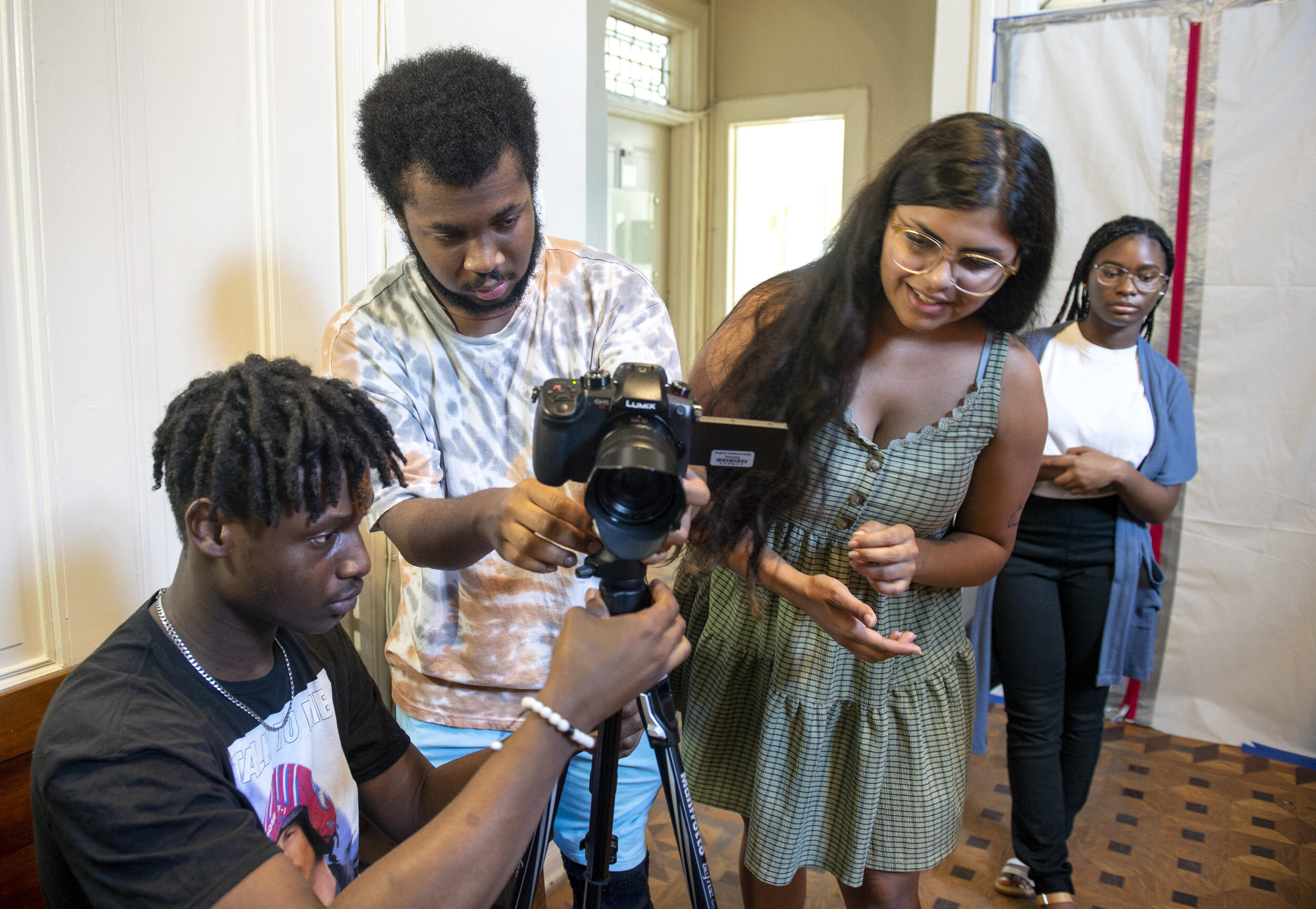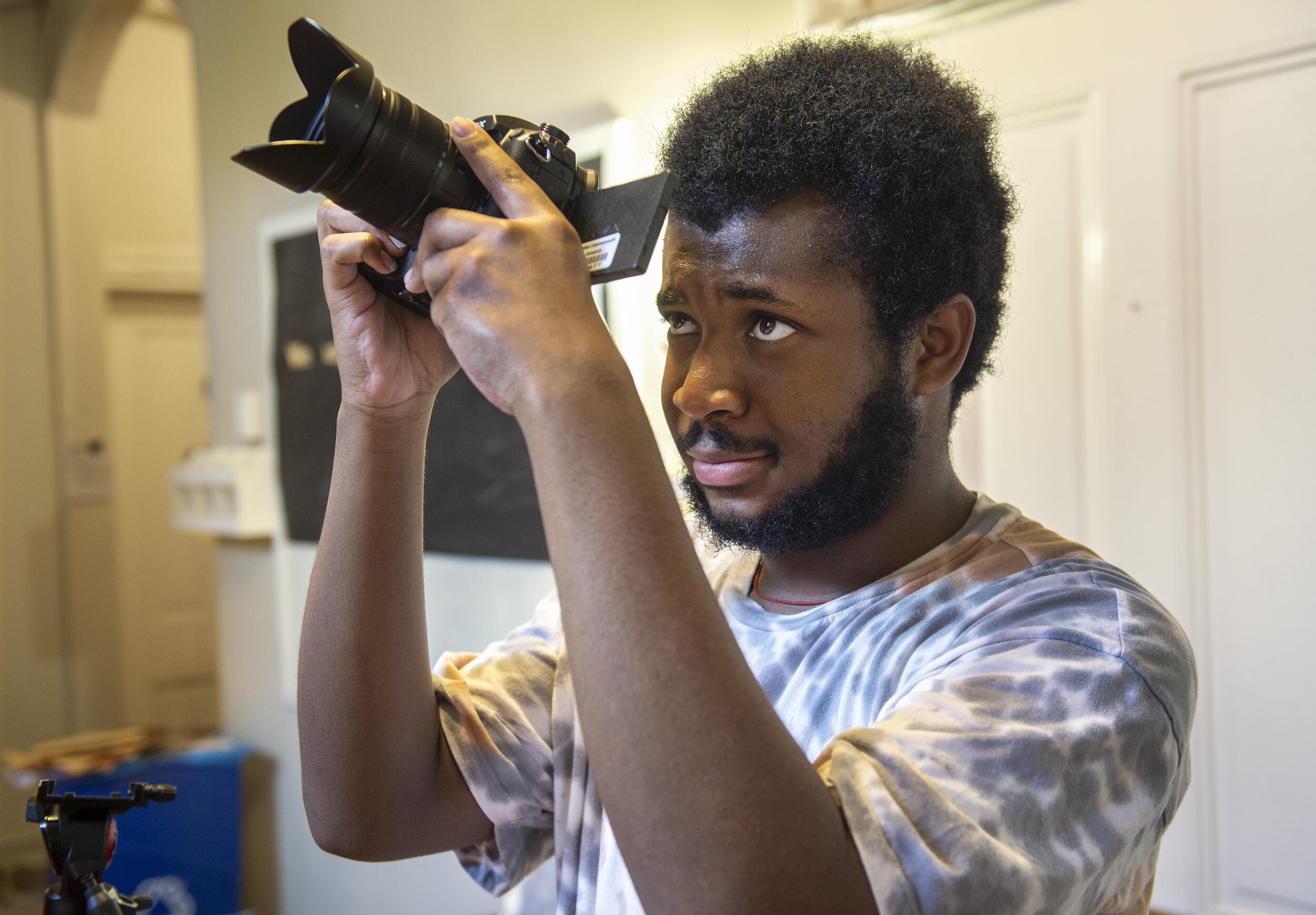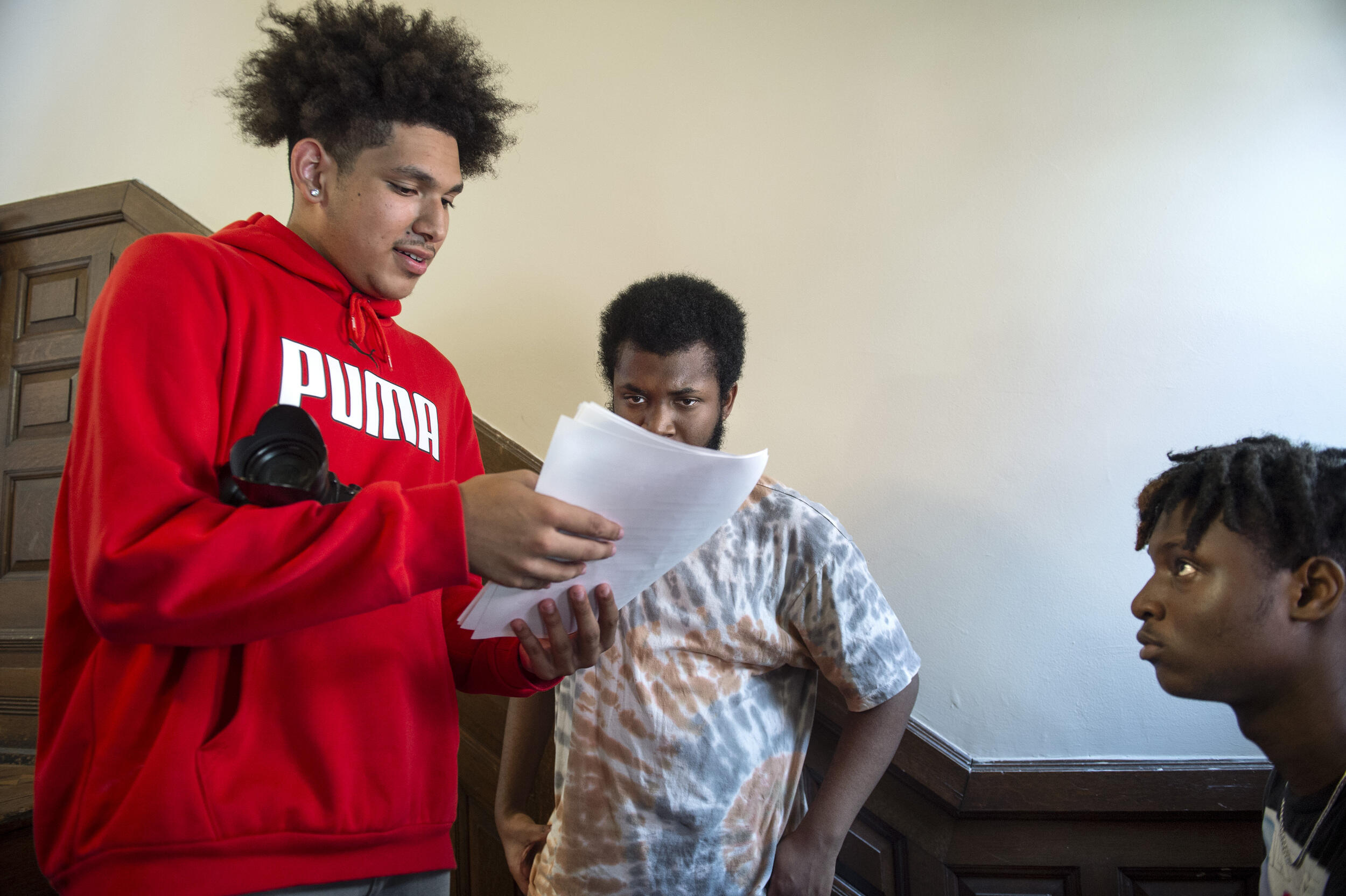
Oct. 24, 2022
East Marshall Street Well Project engages community through film camp, K-12 education and archival research
Share this story
Josue Dejesus, a student at George Wythe High School in Richmond, is directing his first short film, a mystery, and is setting up a shot on the wood-paneled staircase of Williams House on West Franklin Street at Virginia Commonwealth University.
“Walk down these steps, and then look up and look mad, like someone stole something from you,” Dejesus instructs Leanna Morris, the star of the scene and a student at Franklin Military Academy. “This is take one. Quiet on the set. Roll camera. Action.”
Dejesus and Morris were among seven Richmond-area high school students who recently participated in a film camp taught by Manavi Singh and Fanxi Sun, graduate film students in the VCU School of the Arts, and led by Shawn Utsey, Ph.D., a documentary filmmaker and professor in the Department of Psychology in the College of Humanities and Sciences.
A “crash course” in moviemaking, the camp trained the students in film photography, lighting, sound, video editing and more. By the end of it, each student had written, filmed and produced their own short film. “I’ve always been interested in film,” Dejesus said. “I just never had the right equipment. And when I was told about this camp, I thought it was a perfect opportunity to kind of start and see if I really would like it.”
The camp was funded by a grant from the National Endowment for the Humanities through the American Council of Learned Societies to expand community engagement related to the East Marshall Street Well Project. The project was formed to facilitate a process with the Richmond community that ensures the appropriate study, memorialization and reburial of the 19th-century remains of at least 44 adults and nine children — most of whom were African or African Americans — discovered in an abandoned well uncovered during construction on VCU’s MCV Campus in 1994.
Utsey’s 2011 documentary, “Until the Well Runs Dry: Medicine and the Exploitation of Black Bodies,” shined a light on the discovery of the remains, which had been largely unaddressed since 1994, in its examination of the issue of grave robbing and use of Black cadavers in medical education during the 19th century.

Using the filmmaking skills they learned at the film camp, several of the high school students will now be developing videos for social media and other platforms to inform the community about the ongoing work of the East Marshall Street Well Project.
“They did incredible, incredible work,” Utsey said. “The VCU Community Film Camp [participants] will now be creating projects in and around the East Marshall Street Well Project to spread the word to the community about what it is, what the plans are, and to encourage folks to get involved or stay involved.”
The film camp is one of three programs funded through the grant, which is co-led by Karen Rader, Ph.D., a professor in the Department of History, and Joseph Jones, a faculty member in the Department of Anthropology at College of William and Mary. The programs, she said, are aligned with the original recommendations of the Family Representative Council, which represents the descendant community and that made recommendations in 2018 on behalf of those individuals whose remains were discovered to support appropriate study, memorialization and reburial with dignity.
The goal is to support implementation of the Family Representative Council’s recommendations by engaging the community through public education, community research and ongoing public communication around the East Marshall Street Well’s history of structural and medical racism.
Leading the community engagement part of the project is Gwen Whiting, who previously was a senior associate with Justice & Sustainability Associates, which ran the East Marshall Street Well Project’s original community consultations.
“True community engagement is being thoughtful and intentional in having a diversity of people and voices involved in the process from beginning to end,” Whiting said. “It especially involves people who are most impacted – the families of the ancestral remains – and advocates such as the Family Representative Council who are standing in the gap for the remains.”
A second part of the grant is focused on education and is led by Ana Edwards, a public historian, longtime historic preservation and community activist, and education programs manager at the American Civil War Museum. Edwards is working with three K-12 teachers who have been named community education fellows and who will incorporate the East Marshall Street Well into their curriculums.
“As the K-12 fellowship cohort, our job is to prepare age-appropriate curriculum modules as a part of the larger goal to disseminate this local history and the results of its ongoing research as widely as possible,” Edwards said. “Our fellows have been elementary, middle and high school teachers with years of curriculum development, including, for one of them, experience teaching the recently implemented, place-based methodology of the REAL Richmond course. As collaborators in an evolving process, we are excited to help move the project further out into the community, as intended.”
The third part is dedicated to community research, and is being led by researcher and advocate Lenora McQueen, a descendent of people interred at Richmond’s long-neglected Shockoe Hill African Burying Ground – the final resting place of an estimated 22,000 free and enslaved African Americans, established in 1816.
McQueen said the research she is conducting through the East Marshall Street Well Project builds on her research on the Shockoe Hill African Burying Ground, which is likely the largest burial ground for free people of color and the enslaved in the United States.
“The majority of the human remains that were disposed of in the East Marshall Street Well would have been stolen from the Shockoe Hill African Burying Ground at 5th and Hospital streets,” she said. “This burial ground was the main target of grave robbers for the Medical College of Virginia, which included at times the doctors, especially the demonstrator of anatomy, and the medical students.”

As part of the research, McQueen searched for records at the Library of Virginia, the Virginia Museum of History and Culture, Richmond Public Library, the Health Sciences Library at VCU and the Valentine about people who would have been buried at the Shockoe Hill African Burying Ground and the people who would have been connected to them.
“In identifying the names of people who would have been buried at the Shockoe Hill African Burying Ground, we will also likely be uncovering the names of people who would have ended up in the East Marshall Street Well,” she said. “This burial ground was purposely made invisible long ago. My goal is to make it visible again, and to restore it and the people buried there to memory. They very much deserve to be remembered, and to honored.”
McQueen was a co-author of the nomination of Shockoe Hill African Burying Ground to be added to the National Register of Historic Places, along with retired archaeologist Dan Mouer, Ph.D., who was on-site when the East Marshall Street Well was discovered; Ryan K. Smith, Ph.D., a professor in the Department of History at VCU; and archaeologist Steve Thompson, Ph.D. Their work led the site to be added to the Virginia Landmarks Register and National Register of Historic Places this year.
The new grant builds on other East Marshall Street Well Project work underway at VCU. In January, the remains of the people discovered in the well were transferred from the Virginia Department of Historic Resources to the VCU Department of Forensic Science, where researchers are seeking to understand more about who the people were and the cultural and historical context in which they lived.
VCU researchers are aiming to answer questions developed by the Family Representative Council related to biochemical and DNA analysis of the remains, including information about the regional genetic ancestry of the individuals; the sex of children and younger adolescents whose sex cannot be determined by physical examination of the bones; the health environments of the individuals; and any connections between individuals whose remains were discovered and potential living descendants.
Subscribe to VCU News
Subscribe to VCU News at newsletter.vcu.edu and receive a selection of stories, videos, photos, news clips and event listings in your inbox.



